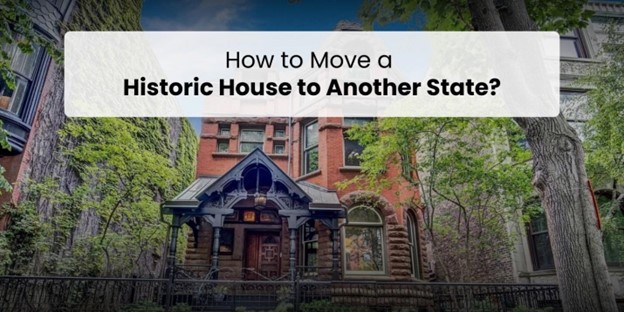
Moving a house is no simple task, and when it comes to moving a historic house, the complexities multiply. Historic homes, with their delicate architecture, period-specific materials, and cultural significance, require special care to preserve their structural and historical integrity.
If you’re contemplating relocating a historic house to another state, here’s a detailed guide to help you understand the process, the challenges, and the solutions, especially with the support of a professional long-distance moving company.
The first step in relocating a historic home is to assess whether it's feasible to move the structure in the first place.
Some historic homes are made from materials that may not survive transportation, such as stone or brick, while others might be too large or complex to relocate.
Steps to Evaluate Feasibility:
● Structural Integrity: Hire an experienced structural engineer to evaluate whether the building can withstand the stresses of moving. They’ll look at the foundation, the type of materials used, and the overall condition of the home.
● Historical Impact Assessment: Consult with local historical preservation societies. Relocating a house may require permissions, as it could affect the historical designation of the building or its status on national or state registries.
● Cost Assessment: Moving a historic home is more expensive than moving a modern house. Ensure that the cost of moving, permits, and reassembly fits within your budget.
Moving a house—particularly a historic one—requires several legal permissions. You’ll need to coordinate with local governments, historical societies, and sometimes state and federal authorities.
Key Permits to Obtain:
● Historical Preservation Permits: If your house is on a historical registry, you'll need special permits to make sure the move complies with regulations.
● Building and Moving Permits: Cities and counties require moving permits that cover everything from the route the house will travel to the utility services that may need temporary rerouting.
● Zoning Approvals: The destination site needs to be zoned properly to accommodate the structure. Historic homes, in particular, may require certain building codes to be met.
One of the most crucial steps in moving a historic home to another state is selecting the right and trusted Chicago moving company. A company experienced in handling historic homes, will be well-equipped to manage the unique demands of this challenging task.
Considerations for Choosing the Right Moving Company:
● Experience in Moving Historic Structures: Not all moving companies have the expertise to handle historic homes. Long Distance Movers specialize in transporting delicate and large-scale items across state lines, making them an ideal choice for such a complex move.
● Licensing and Insurance: Ensure the company is fully licensed and insured for interstate moves, and make sure their insurance covers historic structures, which may require more comprehensive policies.
● Specialized Equipment: Moving a historic home requires specialized equipment like hydraulic jacks, cranes, and flatbed trailers. Your moving company should provide these tools and the necessary expertise to use them safely.
Before moving a historic home, the structure must be properly prepared to ensure its safe relocation. This process involves several critical steps.
Preparation Process:
● Structural Reinforcement: The movers will need to reinforce the house’s structure to prevent damage during transport. This often includes adding temporary supports and removing non-structural elements like porches or chimneys.
● Protecting Delicate Features: Historic houses often contain fragile elements such as stained-glass windows, detailed woodwork, and vintage fixtures. These should be carefully removed, labeled, and transported separately to avoid damage.
● Disassemble and Catalog: In some cases, part of the home, such as wings or outbuildings, may need to be disassembled and reassembled at the new location. Detailed catalogs of all removed elements should be created to aid in reassembly.
Moving a historic home across state lines requires intricate planning and coordination. The moving company Chicago will typically handle the logistics, but it’s important for the homeowner to stay involved throughout the process.
Key Logistics:
● Route Planning: Moving a house across state lines means navigating roads, bridges, and possibly even railroads. The moving company will need to plan a route that avoids obstacles like low bridges or narrow roads. This may involve temporarily removing utility lines or getting clearance from the Department of Transportation.
● Timing: Interstate moves of historic homes can take several days or weeks. The exact timing depends on the distance, size of the house, and any road-related challenges.
Once the historic house arrives at its new location, the process of reassembly and restoration begins. This stage is as critical as the move itself, ensuring that the house retains its historical integrity.
Post-Move Steps:
● Rebuilding on a New Foundation: Before the house is moved, a new foundation must be laid at the destination site. Once the house is placed on the new foundation, the movers will work to ensure that it is secure and level.
● Restoring Historical Elements: After the house is reassembled, historical elements like woodwork, doors, windows, and fixtures must be restored and reinstalled. Any damage sustained during the move should be repaired by specialists familiar with historical restoration.
Moving a historic house across state lines is a complex, but achievable task when approached with careful planning, professional help, and the right expertise. By working with a reputable company you can ensure that your historic home will be relocated safely, preserving its integrity for generations to come.
From securing permits and evaluating the feasibility to handling logistics and restoration, every step should be meticulously planned to make the move as smooth as possible.